-
2500 S Ann Arbor Ave, Oklahoma, OK 73128, USA
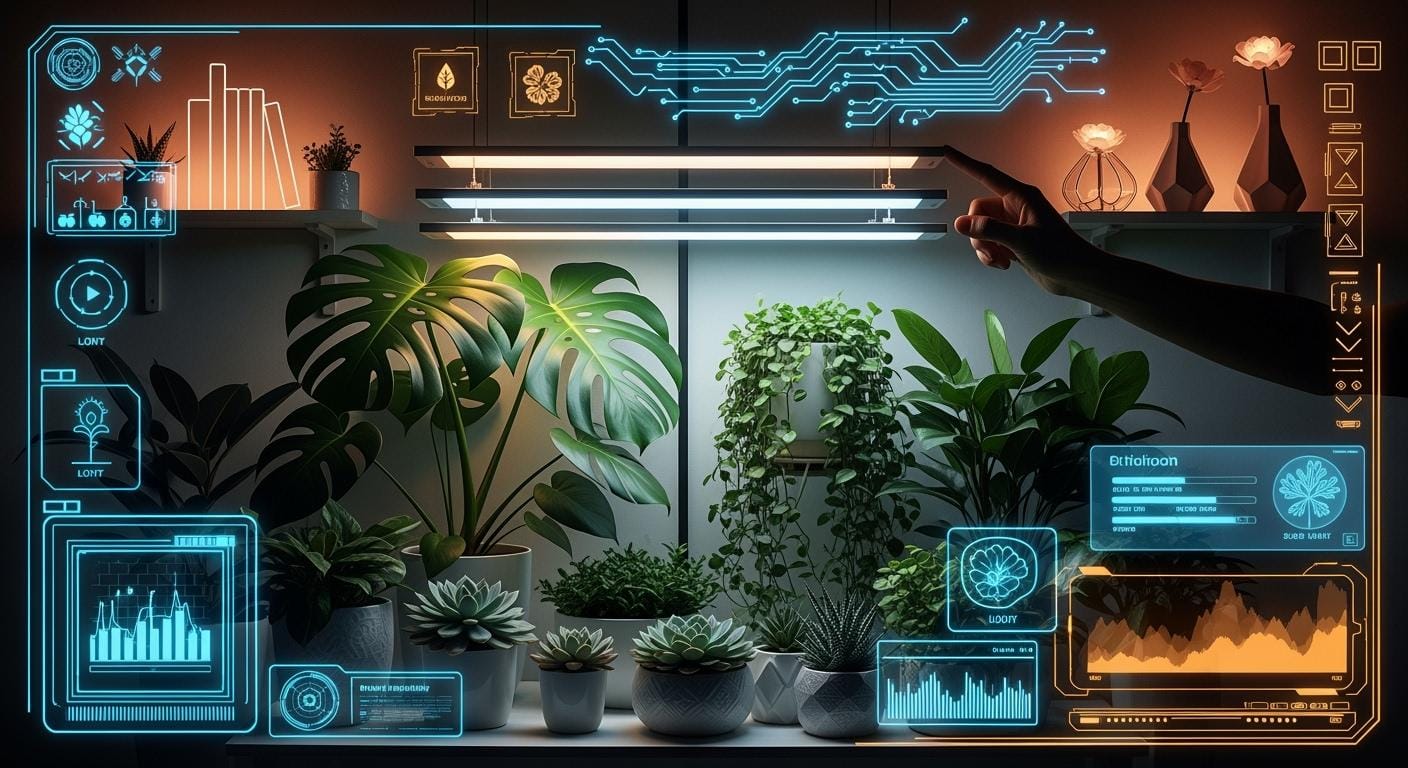
Best Grow Lights for Indoor Plants You Can Trust
If you want your houseplants to thrive, you need reliable lighting. Some of the best grow lights for indoor plants include the SLTMAKS 1000W LED Grow Light, Barrina, Sansi, and Hytekgro. The SLT STG-1000W-F Series stands out for its advanced spectrum and high output, making it a top choice for serious indoor gardeners. You can trust these options because they deliver tested performance, energy efficiency, and strong user reviews. Check out how top-rated grow lights compare below:
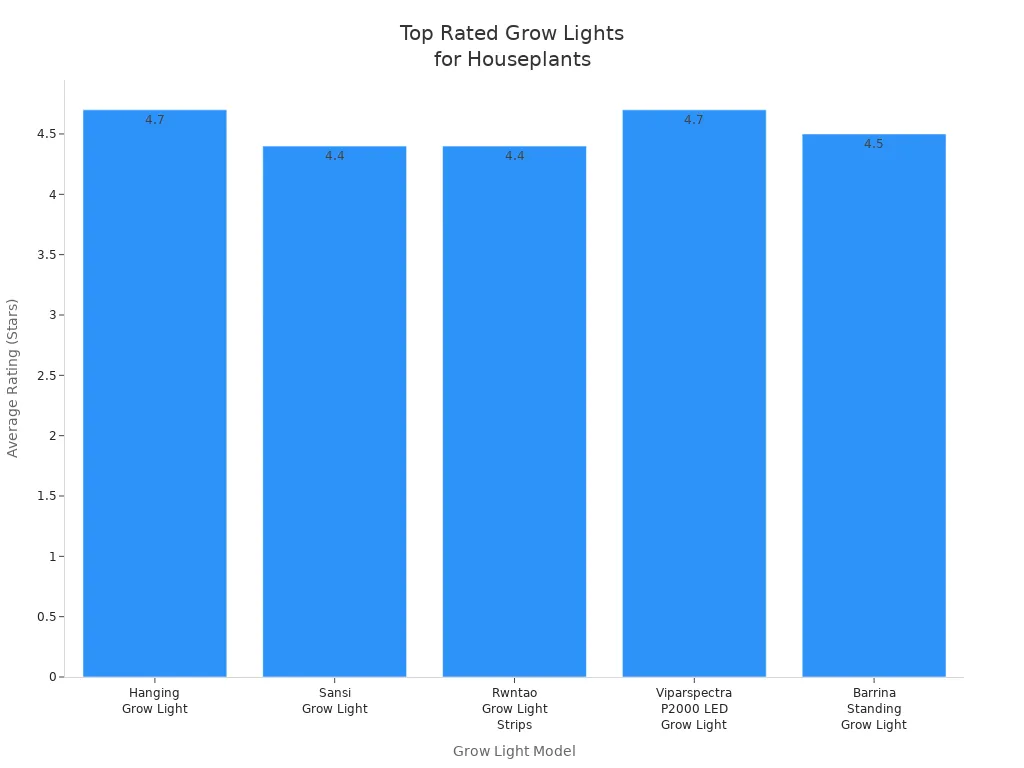
With these picks, you give your houseplants the light they need to grow strong all year.
Table of Contents
Key Takeaways
- Choose full-spectrum grow lights for healthy plant growth. They provide the right wavelengths for every growth stage.
- Consider the SLT STG-1000W-F Series for large indoor gardens. It offers high output and wide coverage for serious gardeners.
- The Barrina T5 LED Grow Light is budget-friendly and great for small plants or seedlings. Its modular design allows for easy expansion.
- Use the Sansi LED Grow Light Bulb for a simple, plug-and-play option. It fits into standard sockets and is perfect for small spaces.
- The Hytekgro LED Grow Light Panel is lightweight and easy to hang. It’s ideal for seed starting and small collections of plants.
- Always match the intensity and coverage of your grow lights to your plants’ needs. This ensures optimal growth and health.
- Set a daily light schedule of 12 to 16 hours for most houseplants. Timers can help automate this process for convenience.
- Regularly maintain your grow lights by cleaning them and checking for any issues. This helps prolong their lifespan and effectiveness.
Best Grow Lights for Houseplants
SLT STG-1000W-F Series LED Grow Light
Features
You want a powerful led grow light for your houseplants? The SLT STG-1000W-F Series gives you exactly that. This full spectrum grow light uses Samsung white LEDs, Epistar red and blue chips, plus UV and infrared. Your indoor plants get everything they need for every stage of growth. The 1000W output covers a big 5×8 foot area, so you can light up a lot of houseplants at once. The advanced heat sink keeps things cool, and the JLC UL driver works with most home setups. You get over 50,000 hours of use, and the IP54 rating means you don’t have to worry about a little humidity. The high PPF of 2900μmol/S means your plants get strong, even light.
Pros & Cons
Tip: If you want a reliable led grow light for your indoor plants, this one delivers high output and a balanced full spectrum.
Pros:
- Advanced full spectrum for all plant stages
- Huge coverage area for many houseplants
- High energy efficiency (over 160LM/W)
- Easy to install and operate
- Long lifespan and strong warranty
Cons:
- Premium features come at a higher price
Best For
You should pick the SLT STG-1000W-F Series if you have a large collection of houseplants or want to grow demanding indoor plants like cannabis or hemp. This led grow light works best for serious gardeners who want the best grow lights for big results.
Barrina T5 LED Grow Light
Features
The Barrina T5 LED Grow Light is a favorite for many houseplant lovers. You get a full spectrum grow light with a 5000K color temperature, which is perfect for seedlings and leafy greens. Each tube uses only 10 watts but puts out about 1100 lumens. The lightweight aluminum build makes it easy to hang or mount anywhere. You can link several tubes together for bigger setups. The rated lifespan is up to 50,000 hours, and you get a 2-year warranty for peace of mind.
| Feature | Barrina T5 |
|---|---|
| Rated Lifespan | Up to 50,000 hours |
| Warranty | 2 years |
| Durability Notes | Lightweight aluminum build |
| PPFD (μmol/m²/s) | ~90–100 at 8″ distance |
| Lumens | ~1100 lumens per tube |
| Spectrum | Full-spectrum (5000K) |
| Energy Consumption | 10 watts per tube |
Pros & Cons
Pros:
- Affordable and energy-saving
- Easy to install and expand
- Great for small houseplants and seedlings
- Lightweight and flexible setup
Cons:
- Lower intensity than some larger led grow lights
- Best for smaller indoor plants or as supplemental lighting
Best For
You should choose the Barrina T5 if you want a simple, budget-friendly led grow light for your houseplants. It works great for shelves, seed starting, or adding extra light to darker corners.
Sansi LED Grow Light Bulb
Features
The Sansi LED Grow Light Bulb gives you a full spectrum option that fits right into a regular light socket. You don’t need any special fixtures. This led grow light bulb folds for easy storage and has a 5-year warranty. It’s affordable and works well for single houseplants or small groups. The full spectrum design helps your indoor plants grow strong and healthy.
Pros & Cons
| Pros | Cons |
|---|---|
| Folds for convenient storage | Large and slightly awkward design |
| Can be plugged into a light socket | Misleading power output |
| Affordable | Requires separate light bulb outlet to function |
| 5-year warranty |
Best For
You should use the Sansi LED Grow Light Bulb if you want a quick, easy way to give your houseplants more light. It’s perfect for small spaces, single indoor plants, or anyone who wants a plug-and-play full spectrum grow light.
Hytekgro LED Grow Light Panel
Features
You want a simple way to help your houseplants grow strong? The Hytekgro LED grow light panel gives you a full spectrum of light that supports every stage of plant growth. Each grow light panel measures 12 inches square, so you can fit it above most trays or pots. You get bright light without worrying about too much heat. The lightweight design makes it easy to hang, even if you have limited space. You can cover about 3 square feet with each panel, which works well for small collections or seed starting.
Here’s a quick look at what you get:
| Feature | Details |
|---|---|
| Lightweight design | Easy to hang |
| Low heat output | Prevents plant burn |
| Bright light | Good for many plant types |
| Size | 12 inches square |
| Light color | Full spectrum |
| Coverage area | 3 feet square per panel |
| Ease of Use Rating | 4.5/5 |
| Effectiveness Rating | 5/5 |
| Durability Rating | 5/5 |
| Value Rating | 5/5 |
| Tester Quote | “I love these lights for starting seeds…” |
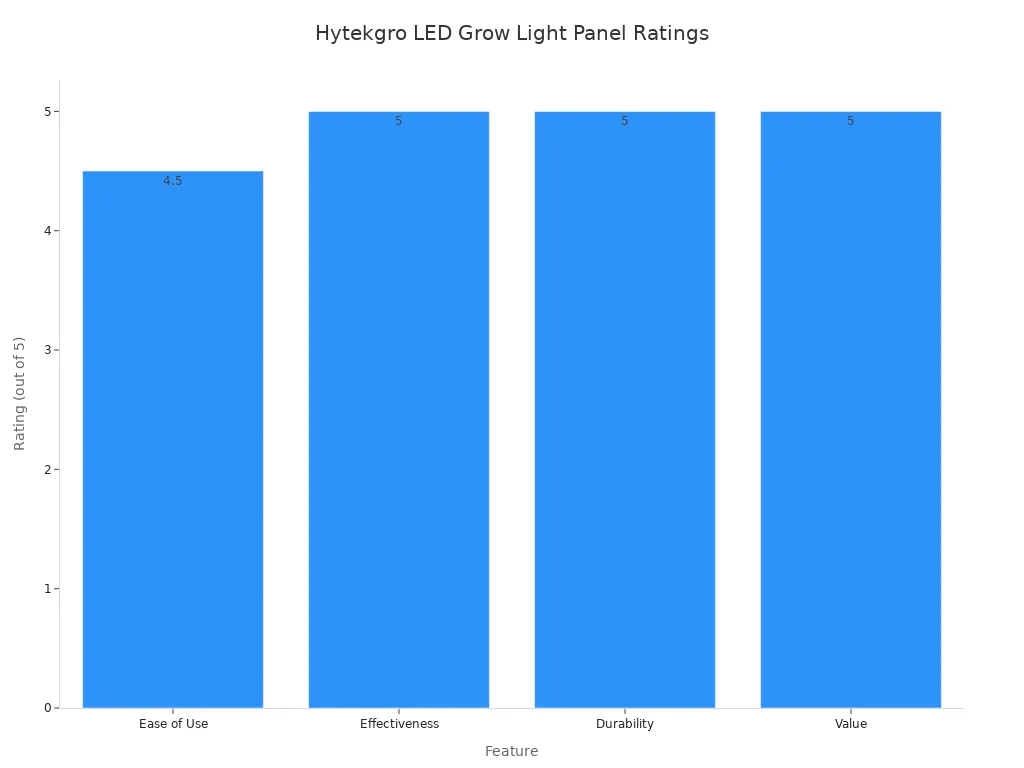
Pros & Cons
Note: The Hytekgro LED grow light panel gives you a purple glow. This helps your houseplants, but it might look odd in your living room.
- You get a full spectrum of light for all plant stages.
- The grow light panel covers about 3 square feet when you hang it 18 inches above your plants.
- Seedlings look healthier and bloom more under this led grow light panel.
- The panel stays cool, so you don’t have to worry about burning your houseplants.
- You need to turn the grow light panel on and off by hand because it doesn’t have a timer.
Best For
You should pick the Hytekgro LED grow light panel if you want an affordable, easy-to-use option for seed starting or small groups of houseplants. This led grow light panel works best for people who want to boost plant health without a complicated setup.
iGrowtek 2ft Grow Light
Features
If you want a led grow light that covers a bigger area, the iGrowtek 2ft grow light might be your best bet. This grow light panel stretches two feet long, so you can use it for trays of seedlings or rows of houseplants. The setup is simple, but you might need a friend to help hang it. The light stays cool and runs all day without overheating. You get steady, bright light that helps your plants grow faster and stronger.
| Features | Feedback |
|---|---|
| Easy setup | Setup needs two people |
| Covers a large area | Light isn’t adjustable |
| Does not overheat | |
| Stays on continuously |
Pros & Cons
- You can grow tomatoes, spinach, and other houseplants that need lots of light.
- Basil plants grow just as well as those in natural sunlight.
- The grow light panel is perfect for starting seeds indoors.
- The light does not adjust, so you get one brightness level.
- You may want to wait for a sale to get the best value.
Best For
You should use the iGrowtek 2ft grow light if you want to start lots of seedlings or grow leafy houseplants in a bigger space. This led grow light panel works well for gardeners who want reliable results and don’t mind a simple, no-frills design.
Other Reliable Grow Lights
Features
You have many choices when it comes to grow lights for houseplants. Some other reliable options include T8 V-shaped LED tubes, quantum board grow light panels, and even plant stands with built-in led grow lights. Many of these grow light panel options use full spectrum light, which helps your houseplants grow healthy and strong. Some models let you dim the light or fold the panel for easy storage.
| Grow Light Description | User Feedback |
|---|---|
| 380-800nm T8 V-shaped LED tube | “Didn’t expect much—surprised me!” |
| 5000W Quantum Board LED | “My plants are thriving with this light!” |
| 5.5ft metal plant stand with LEDs | “Looks great and helps plants grow fast!” |
| 500W-1000W LED with Samsung diodes | “Works great for my seedlings!” |
| Dimmable quantum LED grow light | “Love the dimming options for different plants.” |
| 12Cells Seed Starter Tray with LED | “Perfect for small spaces and seed starting.” |
| Full spectrum phytolamp | “Easy to use and my plants love it.” |
| 5V USB Led Grow Light | “Timer makes growing so simple.” |
| Full spectrum LED grow light bar | “Good power and foldable for easy storage.” |
Pros & Cons
- You can find grow lights for every budget and space.
- LED grow light panels use less energy and stay cool.
- Some grow light panel models let you switch between different light colors.
- Incandescent lights cost less but use more energy and get hot.
- Fluorescent grow lights give you a wide spectrum and low heat.
Best For
You should try these other grow light panel options if you want to experiment with different setups or need something special for your houseplants. Many of these led grow light panels work well for seed starting, small spaces, or even as a stylish addition to your home.
Best Grow Lights for Indoor Plants: Comparison Table
Do you want to compare the best grow lights? This table makes it easy to see your choices. You can quickly check wattage, spectrum, coverage, energy use, and warranty.
Specs Overview
| Product | Wattage | Spectrum | Coverage Area | Energy Efficiency | Warranty |
|---|---|---|---|---|---|
| SLT STG-1000W-F Series | 1000W | Samsung full spectrum + UV/IR | 5×8 ft | 160LM/W | 3 years |
| Barrina T5 LED Grow Light | 10W/tube | Full spectrum (5000K) | Varies (modular) | High | 2 years |
| Sansi LED Grow Light Bulb | 15W | Full spectrum | 1-2 ft | High | 5 years |
| Hytekgro LED Grow Light Panel | 45W | Full spectrum | 3 sq ft | High | 1 year |
| iGrowtek 2ft Grow Light | 40W | Full spectrum | 2×4 ft | High | 1 year |
| Spider Farmer SF2000 | 200W | Samsung LM301H EVO | N/A | High | 5 years |
| Mars Hydro TS1000 | 150W | Full spectrum | N/A | High | 3 years |
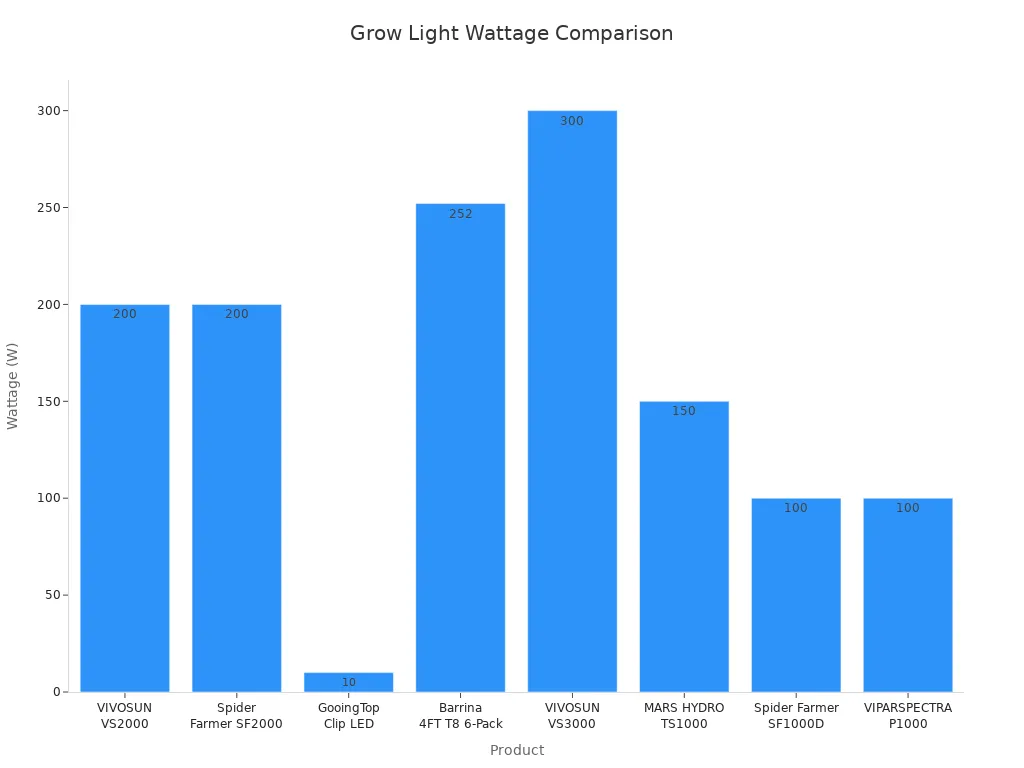
If a grow light has a longer warranty, you can feel safer. High energy efficiency means you save money on power.
Pros & Cons Summary
Want to know what’s good and bad about each grow light? Here is what people like and dislike about the top choices.
| Grow Light Model | Advantages | Disadvantages |
|---|---|---|
| SLT STG-1000W-F Series | Huge coverage, advanced spectrum, easy setup, durable | Higher price |
| Barrina T5 LED Grow Light | Affordable, modular, easy to expand | Lower intensity, best for small areas |
| Sansi LED Grow Light Bulb | Plug-and-play, compact, long warranty | Limited coverage |
| Hytekgro LED Grow Light Panel | Lightweight, cool operation, good for seedlings | No timer, purple glow |
| iGrowtek 2ft Grow Light | Covers large trays, simple design | Fixed brightness |
| Spider Farmer SF2000 | Even light, water-resistant, quiet | Higher price |
| Mars Hydro TS1000 | Great value, easy to install, minimal heat | May be small for big spaces |
- The SLT STG-1000W-F Series gives strong, full spectrum light.
- Barrina T5 tubes are good if you want to add more lights later.
- Sansi bulbs fit in normal sockets, so you do not need special lamps.
- Hytekgro panels stay cool and help young plants grow well.
- iGrowtek lights cover more space for trays and rows.
- Spider Farmer and Mars Hydro work well for many plant types.
If you want the best grow lights, look for high energy savings and a good warranty. Pick the one that fits your space, budget, and number of plants. Good grow lights help your indoor garden look better and grow stronger.
How We Chose the Best Grow Lights
Reliability
When you pick grow lights for your indoor garden, you want something that works every time. That’s why we put each light through a real-world review. We tested every model by growing three types of houseplants under each light for four weeks. You can see which lights help your plants grow taller, fuller, and greener. We also checked how easy it is to set up each light and if you need any special tools. If a light has extra features, like timers or dimmers, we made sure they work as promised. You don’t want surprises when you care for your houseplants. We measured how fast seedlings sprout and how healthy the plants look. This way, you know which grow lights are reliable for your indoor garden.
Light Spectrum
You might wonder why full spectrum lighting matters so much for houseplants. Plants need different colors of light to grow well. Full spectrum grow lights give your indoor garden a wide range of wavelengths, just like sunlight. This helps your plants with every stage, from sprouting to blooming. Here’s why you want full spectrum lighting:
- Full spectrum white light covers all the colors your houseplants need.
- This type of light acts like natural sunlight, so your plants get balanced energy.
- Far red light, which goes up to 780 nm, boosts plant growth and helps them make more food.
- Studies show that far red light can increase plant size and speed up photosynthesis.
If you want the best for seedlings or mature houseplants, always look for full spectrum grow lights. Your plants will thank you with stronger stems and brighter leaves.
Intensity & Coverage
Not all grow lights work the same for every indoor garden. You need to think about how much light your houseplants get and how far the light reaches. If you put your plants near a big window, they get more light. But if your space is dark, you need a grow light with strong intensity and wide coverage. Here’s what you should know:
| Measurement Type | Description |
|---|---|
| PPF | Shows how much plant-usable light a bulb gives off each second. |
| PPFD | Tells you how much of that light actually hits your plant’s leaves. |
| Foot-candle | Measures light on a one-square-foot area, one foot from the source. |
| Lumens | Measures brightness for your eyes, not for plant growth. |
| Watts | Tells you how much energy the light uses, not how bright it is. |
You want to place your grow lights at the right height for the best results. For seedlings, keep the light 4-6 inches above. For leafy houseplants, 12-24 inches works best. If you grow herbs or flowers, try 6-12 inches. The best budget grow lights still need to give enough intensity for your indoor garden. When you read a review, check if the light covers your whole plant shelf or just a small spot. The best for seedlings will always mention strong coverage and even light.
Tip: If you want healthy houseplants, always match the intensity and coverage of your grow lights to your plant’s needs. This helps your indoor garden thrive, even if you’re on a best budget plan.
Energy Efficiency
You want your grow lights to help your plants without running up your electric bill. Energy efficiency matters a lot when you choose a grow light for your indoor garden. LED grow lights stand out because they use less power and last longer than other types. You save money every month and help the environment at the same time.
Take a look at how different grow lights compare on energy use and cost:
| Light Type | True Wattage | 12h/day Monthly Cost | 18h/day Monthly Cost | Yearly Cost (Average) |
|---|---|---|---|---|
| LED 450 W | 450 W | $27.54 | $41.36 | ~$496.32 |
| LED 800 W | 800 W | $48.96 | $73.44 | ~$656.00 |
| HID 600 W | 640 W | $39.01 | $58.51 | ~$585.60 |
| HID 1000 W | 1080 W | $65.84 | $98.76 | ~$986.40 |
| Fluorescent 250 W | 250 W | $15.30 | $22.95 | ~$229.20 |
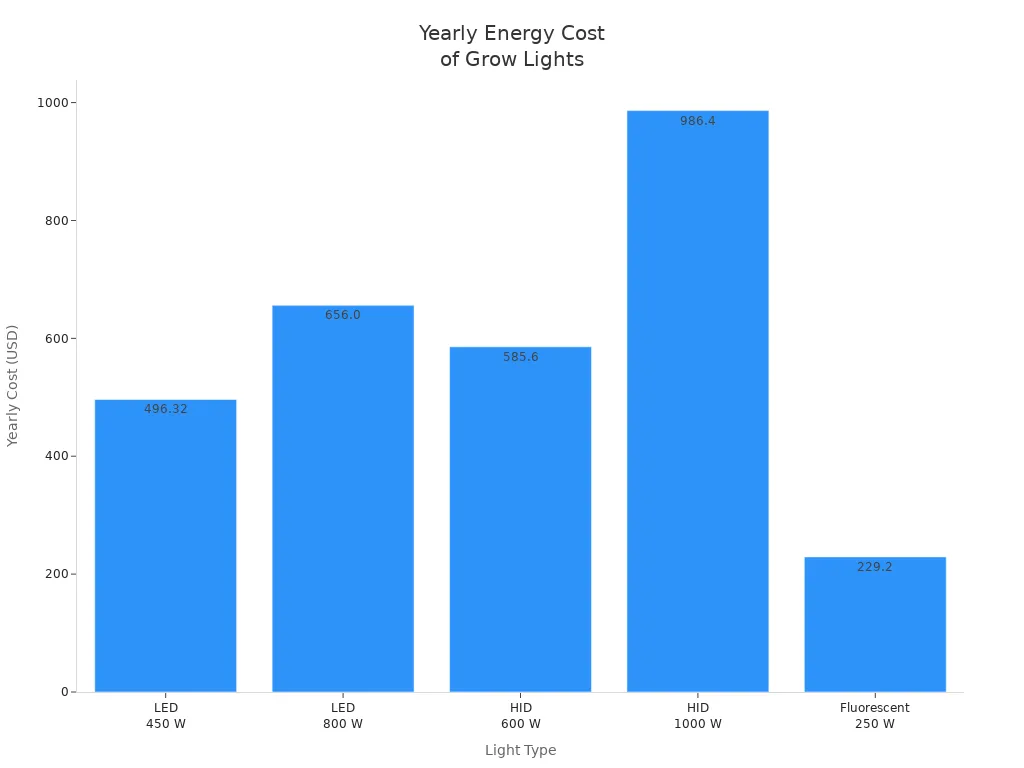
You can see that LED grow lights cost less to run than HID or fluorescent lights. For example, an 800W LED costs about $656 a year, while a 1000W HID can reach almost $1,000. That’s a big difference if you want to keep your plants healthy and your bills low. If you care about saving energy and money, LED grow lights are the smart choice.
Tip: Choose high-efficiency LEDs for your indoor garden. You get strong light for your plants and keep your energy costs down.
User Reviews
You want to know what other plant lovers think before you buy a grow light. User reviews give you real feedback and help you spot the best features. Here are some trends you’ll notice when you read reviews for top-selling grow lights:
- Full-Spectrum Dominance: People love lights that mimic sunlight. These help plants grow at every stage.
- Smart and Automated Features: Many users want timers and smartphone controls. These make it easier to manage your lights.
- Energy Efficiency and Sustainability: High-efficiency LEDs get lots of praise. Users like saving money and helping the planet.
- Design and Aesthetics: Grow lights that look good and fit into home decor get extra points.
If you want a grow light that makes your life easier, look for these features in user reviews. You’ll find that happy customers talk about strong plant growth, easy setup, and low energy bills.
Value
You want the best bang for your buck when you shop for grow lights. Value means more than just price. You should look at what you get for your money. A good grow light gives you strong performance, long life, and useful features. You don’t want to pay extra for things you don’t need.
Here’s what makes a grow light a great value:
- Long Lifespan: Lights that last 50,000 hours or more save you money over time.
- Warranty: A solid warranty protects your investment. You feel safer if something goes wrong.
- Coverage Area: Bigger coverage means you can grow more plants with one light.
- Easy Setup: Lights that are simple to install save you time and hassle.
- Extra Features: Timers, dimmers, and smart controls add convenience.
If you want to get the most value, match your grow light to your space and plant needs. You’ll enjoy healthy plants and keep your costs low.
What to Consider When Buying Grow Lights
Spectrum
When you shop for grow lights, you want to make sure your houseplants get the right spectrum. Spectrum means the range of colors the light gives off. Plants use different colors for different growth stages. Blue light helps leaves grow strong. Red light supports flowering and fruiting. Full-spectrum LED lights combine blue, red, and other colors to mimic sunlight. This helps your houseplants grow healthy from seedling to bloom.
Here’s a quick look at the types of grow lights and what they offer:
| Type of Grow Light | Characteristics |
|---|---|
| Full-Spectrum LED | Higher ratio of blue and red light, emphasizing peaks for plant growth. |
| Broad-Spectrum LED | Even distribution of wavelengths, promoting overall plant health without focusing on specific stages. |
| Targeted Spectrum LED | Emits specific wavelengths for different growth stages, focusing on blue and red light. |
| Color Temperature | Affects plant perception and reaction to light, influencing growth and development. |
Tip: If you want your houseplants to thrive, choose a full-spectrum LED for balanced growth. Broad-spectrum LEDs work well for overall health, while targeted spectrum LEDs help with specific needs.
- Light spectrum matters for plant growth. Each stage needs certain wavelengths.
- Color temperature changes how your houseplants react to light.
- Broad-spectrum lights boost overall health by giving a range of wavelengths.
Intensity
Light intensity tells you how strong the light is. Your houseplants need different levels of intensity based on their type. Some plants love bright light, while others do better with less. You can measure intensity in foot-candles (FC). If you have high-light houseplants, you need more intensity. Low-light houseplants need less.
Check out this table to match intensity to your houseplants:
| Light Condition | Measurement (FC) | Action Required |
|---|---|---|
| Direct Sun | 3000 – 8000 | Assess duration and compare with plant tolerance |
| Indirect Light | < 100 | Move closer to window or use grow lights |
| 100 – 200 | Good for low-light plants | |
| 200 – 400 | Suitable for moderate-light plants | |
| 400+ | Ideal for high-light plants |
If you want to grow high-light houseplants, place your grow light closer or pick a stronger model. For low-light houseplants, use a dimmer setting or move the light farther away. Always check the plant’s needs before you buy.
Energy Use
Energy use matters when you pick a grow light for your houseplants. You want strong light, but you also want to save on your electric bill. LED grow lights use less energy than older types. You can match the wattage to your houseplants’ needs.
Here’s a simple guide:
| Plant Type | Recommended Watts per Square Foot |
|---|---|
| High Light | 25 W |
| Low Light | 16 W |
If you grow high-light houseplants, use about 25 watts per square foot. For low-light houseplants, 16 watts per square foot works well. Always check the label before you buy. You save money and help the environment when you choose energy-efficient LEDs.
Note: Pick a grow light that matches your houseplants’ light needs and your budget. Energy-efficient models keep your plants happy and your bills low.
Size & Setup
When you pick a grow light, you want it to fit your space and make your setup easy. If you garden indoors, space can get tight. You need to think about where your plants will go and how you’ll arrange your lights. Here are some smart ways to make the most of small spaces:
- Choose compact plants. Pick varieties like cherry tomatoes, dwarf citrus trees, or small herbs such as thyme and basil. These take up less room and still give you great results.
- Use wall space. Hang planters or mount them on the wall. This saves floor space and adds a cool look to your indoor garden.
- Stack your plants. Try tiered plant stands or shelves. You can fit more plants without crowding your room.
You should also check the size of the grow light itself. Some lights are long bars, while others are small bulbs or panels. If you have a shelf or a tight corner, measure first. Make sure your light covers all your plants. If you want to grow more, look for modular lights you can add later. Easy installation matters too. Many lights come with hooks, brackets, or stands. You want a setup that lets you move things around without hassle.
Tip: Always plan your plant layout before you buy a grow light. This helps you avoid wasted space and makes your garden look neat.
Ease of Use
You want a grow light that’s simple to use, especially if you’re just starting out. Some features make your life much easier. Take a look at this table to see what helps beginners the most:
| Feature | Benefit |
|---|---|
| Pulleys | You can adjust the light height easily. This helps you get the right distance for your plants. |
| T5 LED or fluorescent lights | These lights are simple to choose and set up. You don’t have to worry about complicated options. |
| Recommended distance from plants | Clear instructions show you how far to place your lights. Your plants get the best growth. |
| Affordable and lightweight T5 bulbs | These bulbs work well in small spaces like basements or spare rooms. You can move them around without trouble. |
If you want less stress, look for grow lights with clear instructions and easy adjustments. Some models let you change the height or angle. Others have timers, so you don’t have to remember to turn them on and off. You should pick a light that matches your comfort level. If you like gadgets, try smart lights with app controls. If you want simple, stick with basic models.
Note: The easier your grow light is to use, the more likely you’ll stick with indoor gardening.
Budget & Warranty
Grow lights come in all price ranges. You want to get the best value for your money. Don’t just look at the price tag—check the warranty too. A good warranty means you can trust your light to last. Here’s a quick comparison of popular models:
| Model | Budget Category | Warranty Period |
|---|---|---|
| HLG 150 Patriot | Mid-range | 3 to 5 years |
| Spider Farmer SF1000 Pro | Mid-range | 3 to 5 years |
| ViparSpectra XS series | Budget-friendly | Decent warranty |
| Spider Farmer SF2000 | Budget-friendly | Decent warranty |
If you want to save money, look for budget-friendly models with solid warranties. Mid-range lights often give you more features and longer coverage. Always check the warranty period before you buy. A longer warranty means less worry if something goes wrong.
Tip: Pick a grow light that fits your budget and gives you peace of mind with a good warranty. You’ll enjoy your indoor garden without surprises.
Grow Lights Setup Tips
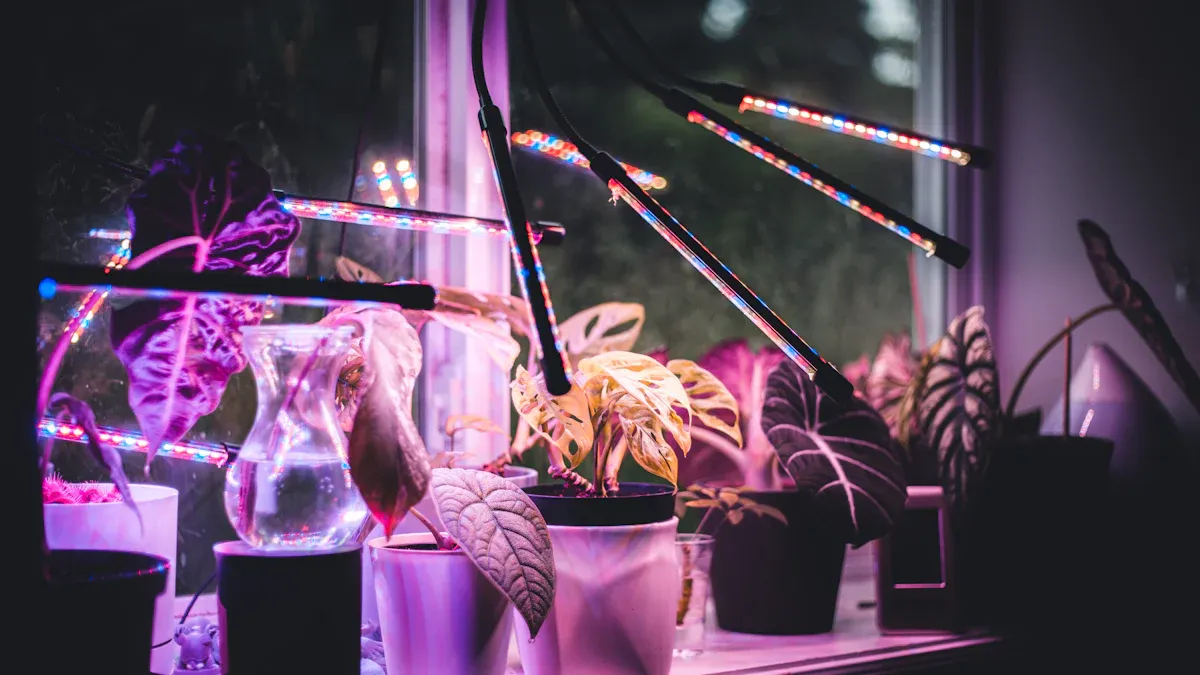
Placement
Getting the placement right makes a huge difference for your indoor plants. You want your grow lights to give every leaf the best chance to soak up energy. Start by measuring the distance from the light to the top of your plants. Most houseplants do well with the light 12 to 24 inches above them. If you use a high-output light like the SLT STG-1000W-F Series, keep it at least 12 inches above the canopy. For smaller lights, you can move them a bit closer.
- Place your grow lights directly above your plants. This helps them grow straight and strong.
- Avoid putting lights too close. You might see leaf burn if the light sits right on top of your plants.
- Spread your plants out so each one gets enough light. Crowded leaves can block the light from reaching lower stems.
Tip: Rotate your plants every week. This helps all sides get even light and keeps your plants looking full.
Timing
You control how much light your plants get each day. Most houseplants need 12 to 16 hours of light. If you want to keep things simple, use a timer. Timers turn your lights on and off automatically, so you never forget.
Here’s a quick guide for timing:
| Plant Type | Hours of Light Needed |
|---|---|
| Leafy houseplants | 12-14 |
| Flowering plants | 14-16 |
| Seedlings | 16-18 |
- Set your timer for the same hours every day. Plants love a steady routine.
- Give your plants some darkness, too. They need rest just like you do.
- If you see your plants stretching or leaning, they might want more light.
Note: Too much light can stress your plants. Stick to the recommended hours for the best results.
Maintenance
You want your grow lights to last a long time and keep working well. A little care goes a long way. Dust and dirt can block light and make your bulbs less effective.
- Wipe your grow lights with a soft, dry cloth every few weeks.
- Check for loose wires or connections. Fix them right away to avoid problems.
- Replace bulbs or panels if you notice flickering or dim spots.
- Keep the area around your lights clean. This helps prevent pests and mold.
Alert: Always unplug your lights before cleaning or making adjustments. Safety comes first!
If you follow these setup tips, your indoor garden will look healthier and grow faster. You’ll see stronger stems, greener leaves, and maybe even more flowers. Happy growing!
You want your houseplants and fresh veggies to thrive, so you need grow lights you can trust. After every review, you see why the SLT STG-1000W-F Series, Barrina, Sansi, and Hytekgro stand out. Each review shows strong performance, easy setup, and real results. To pick the right light, follow these expert tips:
- Understand the light spectrum your plants need.
- Match the light to your plant type.
- Adjust intensity for each growth stage.
- Make sure you get even coverage.
- Set a daily light schedule.
Every review helps you make a smart choice. You can feel confident and enjoy a healthy indoor garden.
FAQ
What is the best grow light for large indoor gardens?
If you want to light up a big space, choose the SLT STG-1000W-F Series. You get strong output, wide coverage, and a full spectrum for all plant stages.
How close should I place my grow light to my plants?
Keep your grow light 12 to 24 inches above your plants. You avoid leaf burn and help every leaf get enough light.
Can I use regular LED bulbs for houseplants?
Regular LED bulbs do not give your plants the right spectrum. You need a full-spectrum grow light for healthy growth.
How many hours should I run my grow lights each day?
Most houseplants need 12 to 16 hours of light. Use a timer to keep your schedule steady.
Do grow lights use a lot of electricity?
LED grow lights use less power than old bulbs. You save money and help the environment.
What spectrum is best for all plant stages?
Full-spectrum grow lights work best. You get blue, red, and other colors your plants need from seedling to bloom.



